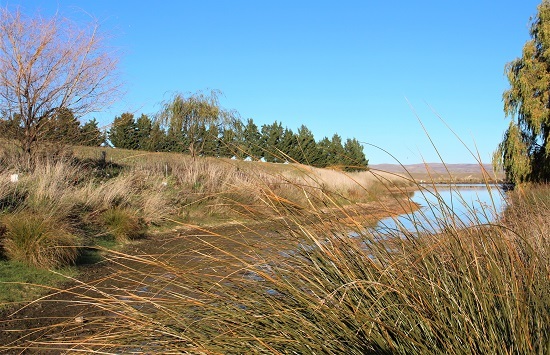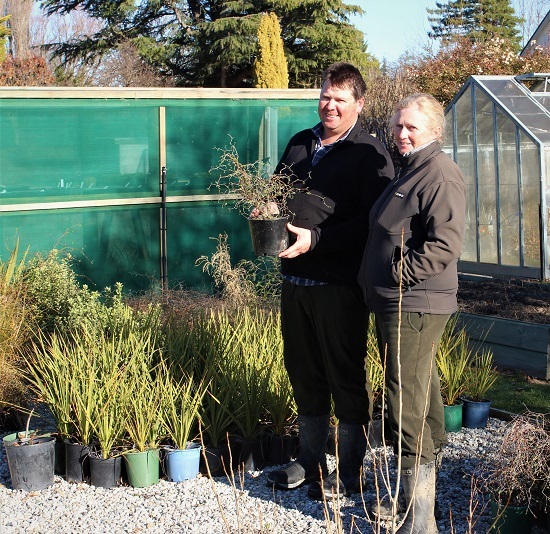Green-fingered Omakau farmers bringing back the birds
Jill Herron
01 June 2022, 6:30 PM
 Anna and Ben Gillespie might be serious about farming cattle for profit but they’ve got a soft spot for lots of other creatures who are looking to settle on the property.
Anna and Ben Gillespie might be serious about farming cattle for profit but they’ve got a soft spot for lots of other creatures who are looking to settle on the property.If the bank manager is okay with it and it’s bringing joy to man, beast, bird and bee… then why not have a water feature in your bull paddock?
There is a greater purpose, of course, to all the planting and landscaping going on at Anna and Ben Gillespie’s 394ha beef and dairy-grazing farm near Omakau.
In what is one of the country’s most arid areas, the native plants, ponds and islands provide shelter for stock and a habitat for native birds, insects, reptiles and fish, where there was none. And it doesn’t take long for new residents to turn up when you provide an enticing environment, the couple say.
“This year for the first time we had masses of frogs back on the farm and our Pukeko population is split now, they used to only be on the top end of the farm, now they’re down the bottom as well.
"We had a flock of juvenile blue herons, all that biodiversity… the birds are coming back and you can’t put a price on that,” Anna said. “It just gives so much more joy on the farm when you see these things while you’re driving around.”
Native falcons had been spotted and the South Island pied oyster-catchers who come inland to breed each year had arrived early this year, she said.
Watching a habitat gradually come to life was a pretty cool thing, not just for the couple but for their two children and others in the community who are taking part. Milly (9) and Will (11) have their own wetland gully on the farm, as do their fellow pupils from Omakau Primary School, who come out each year to plant and check on its progress.
It wasn't a huge financial investment, as much of fencing was associated with a change in farming practice involving the installation of two centre pivot irrigators. Most of the approximately 10ha of wetland was under the pivots, providing water for plants and for filling ponds.
The couple have purchased some native plants each year - after an initial mass planting of exotic species for shelter belts - but with now producing cuttings by the hundred and growing plants from collected seed, orders to commercial nurseries are becoming a thing of the past.
It is time consuming – the couple reckon they can plant 35 plants an hour – and if any then succumb to the wind, cold or dry after all the effort that’s gone in to get them that far, it can be costly.

Islands are safe places for birds to nest and live. This new wetland is one of six where planting will continue for many years to come.
Using a digger that comes on to the farm for other tasks, the couple have created ponds in shallow gullies and depressions in six areas. These are fenced off from stock but still provide shelter.
Wetlands are like giant sponges and do absorb runoff from stock. On Gillespie’s intensively-managed property there is no run-off, Anna says, as the couple give as much weight to science as they do commerce in running their business.
Anna has a Master’s Degree in Applied Science in Farm Management Consultancy as well as a BCom and Certificate in Sustainable Nutrient Management.
Ben also has a tertiary qualification and extensive management experience, although you certainly don’t need all that to propagate your own natives, he says.
He reckons anyone who can grow a carrot in a home veggie plot can do it and hundreds of plants can be propagated for next to nothing, with just a “basic set-up”.
“It’s no harder than growing vegetables and when you’re starting out you might just have an old table in the garage.”
Success is not hard to come by and getting a bit hooked on what for many is a hobby can make it happen rather easily.
When there is resistance to a gentle tug on those first little cuttings (that tells the grower they’ve grown roots in their tray), new propagators can feel a bit like they have discovered a new super power… no more buying plants when you can create your own.
Ben says running the plant nursery is integrated into work time on the farm and isn’t really a hobby - although he does admit he’s put lights in his potting shed for occasions when he might be inclined to potter in the evening.
The Gillespies only began the project four years ago but the speed with which young plants have become ready to leave the sheltered nursery has been a surprise.
Ben now has a steady flow of seedlings graduating out of the potting shed and, instead of two years to establish and harden off before being planted out to survive on their own, many have been large and robust enough after one year. Many have established themselves much quicker than anticipated once out in the wetlands too.

Carex secta has taken to Omakau’s microclimate like a duck to water, readily growing from seed and quickly establishing itself out on the farm.
Surpluses of young plants have even been too much at times for the couple to deal with, but a quick post on social media sees them off to a new home somewhere in the valley.
That and workshops held at the property, led by Cromwell-based dryland plant expert Jo Wakelin, is encouraging the propagation bug to spread in the valley.

The couple with a young Kowhai tree that will eventually go out for planting on the farm.
Thriving now in the wetlands in their hundreds are Olearia, Pittosporum, Coprosma, Totara, Ribbonwood, Cabbage Trees, Mountain and Swamp Flax, Kowhai and more.
The Kowhai seeds are gathered by the whole family each year from an old tree on a typically dry local hillside, in what’s become a family tradition.
This is, perhaps, what the project is about – leaving the land better than it was, for the next generation. And having fun doing it.



